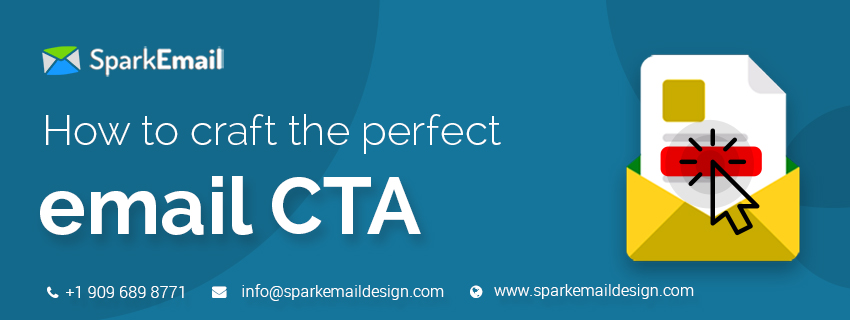CTA’s provoke to drive readers to action, but since we are exposed to them so often, we filter them out when browsing online content—largely when it comes to email campaigns.
If you want your emails to catch your recipient’s eye in their overflowing mail inbox, your business needs to build email CTAs that impel readers to undertake action instantly—and that’s a quite a task.
Here are a few ways to formulate email CTAs that your readers can’t resist clicking, so you can break through the noise and propel elevated email engagement and sales.
But before that, it is fundamental to understand…
Why are email CTA’s different?
The most crystal clear difference is that you have very restricted space to work with and there’s no room for getting sidetracked.
Each word in your email counts, as in some way it is leading up to your CTA or credibly supporting your CTA, which is the tough aspect of email CTAs.
You can begin your email by sharing a story that has a foolproof point and instigates readers to take action.
Being constricted by space isn’t all that bad a deal It drives you to consider each and every word in your email, which will consequently result in a stronger copy and invoke people to carry out an action.
When it comes to email CTAs, length doesn’t really influence SERP rankings, keeping in mind that your reader’s attention span is limited, so even a single word has to earn its way into your email with a target of maximizing the time you get with your subscribers.
Take into account that your call-to-action is not merely a simple button or a short sentence at the bottom of your email design. A solid CTA commences with an effective subject line and follows completely, through the entire email to your PS.
Plenty of email marketers think of a call-to-action as a sole factor in their content that can stimulate people to action with one easy phrase:
Read More. Download. Join Now.

Your link/button is simply a part of the CTA—admittedly a crucial part—but it does not stand a chance by itself.
So, how do you craft an effective email call-to-action?
Here’s how to build a powerful email CTA :
1.Define the goal/ purpose of your call-to-action
Prior to writing your CTA, its an absolute essential for you to define the objective of it.
Exactly what action do you want people to carry out and how do you manage to get them to take it?
Here is what most businesses would do:
Draft an email with images of their new products/services and finish off with a button that says: “Shop now.” / “Buy now”
Does this work?

Here is what you could do instead.
You precisely know what action you want people to take on, so now introspect yourself as to how?
What is the USP of your product/service? What value is your service/product giving your target segment that they cannot get elsewhere?
2. Write a compelling call-to-action copy
Your CTA copy is what eventually persuades your subscribers to take on the action—or not.
You must make a killer value proposition if you intend on people clicking-through.
Each CTA in your email marketing campaign must trigger a distinct emotion in your subscriber.
Restrain from overusing the same CTA in every nook and cranny of your email. Switch it up and spark off differing emotions with your CTAs.
The action is similar, but your modus operandi is different.
By employing multiple CTAs that have identical goals but communicated differently, you strengthen your chances of hitting your readers’ sweet spots and ultimately get them to click.
Additionally to this, the importance of NOT writing “sign up” or “click here” cannot be emphasized enough.

No matter whether you use buttons or embedded text, your CTA by no means should be generic.
People need to be able to distinguish amongst the CTAs and recognize which one to click when they want to take a particular action.
When composing your CTA, keep it brief, relevant and intriguing.
3.Design a CTA readers will click
Weigh a few final points you should consider before sending out your email campaign.
Firstly, don’t ever go overboard by including too many CTAs in your email.
Note that this doesn’t necessarily mean you can’t add multiple links and buttons; it simply means the intent of them must be the same in each.
If and when using buttons, be careful not to add too many.
Doing so will create a circumstance of confusion for readers and they will refrain from clicking them.
An alternative option is to make use of embedded commands in the copy. Embedded commands are in-text links, elaboratively this means that you link a section of a sentence instead of simply pining buttons.
By including embedded commands in the copy, you doge breaking up the flow of the email thereby making it more legible.
Simultaneously you also appeal to the many skim readers. A skim reader is plausibly much more likely to click a link that has an instruction such as “View the new summer collection now” than an upfront “click here”.
A good rule of thumb is that if you have a lot of text copy in your email campaigns, you must try and adopt embedded commands, and if you have a lot of visuals like product images buttons generally tend to be more effective.
Test to see which option works best for your email marketing campaigns.
You are now all set to create effective CTAs for your emails and increase engagement and sales. Let us know what are your favorite email CTAs? Do you have any advice not mentioned in this post? Do tell us at: info@sparkemaildesign.com
